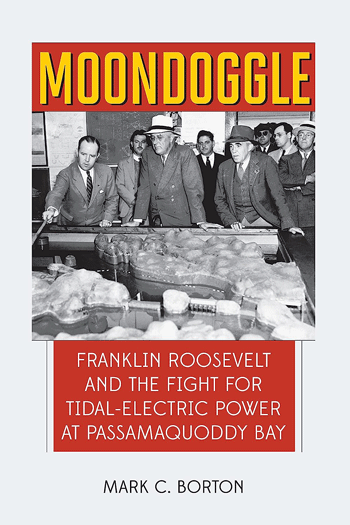Moondoggle: Franklin Roosevelt and the Fight for Tidal-electric Power at Passamaquoddy Bay
By Mark C. Borton, Downeast Books (2023)
A rival to the Hoover Dam in Eastport? That could have been the Quoddy project to generate electricity from one of the highest tides in the world.
For Mainers, the ghost of Quoddy still exists as opportunity lost. The details, in all their shame and glory, are now exposed for all to see in the new book Moondoggle by Mark C. Borton. This is the first full accounting of the dream to harness perpetual tidal power for the nation soon to become the most powerful in the world.
Although small tidal mills existed throughout the coast of Maine starting in the 1600s, harnessing Passamaquoddy Bay was an enormous multi-dam venture with thousands of workers building it in the 1930s. It started as an idea hatched by the brilliant engineer Dexter Cooper who designed hydropower projects from the Mississippi to the Soviet Union. His bride was a summer resident of Campobello Island, Canada, just across the strait from Eastport.
Campobello was also a summer retreat for the Roosevelts of New York.
It is a story featuring power and politics and leaves us with many “what ifs.”
Moondoggle follows the twists and turns of an idea to build dams and huge reservoirs fed by the Eastport tides. The book follows the perspectives of Cooper (the engineer), Franklin Roosevelt (starting from his time as Under Secretary of the Navy), and Roscoe Emery, the prominent publisher of Maine’s then longest continually operating newspaper, the Eastport Sentinel.
The project shifted from private enterprise, to international (with Canada), to public-private, to a public works project, and faced hurdles every step of the way. The players included the citizens of Eastport, Washington politicians, the press, the U.S. Army, the Passamaquoddy Nation, industries, and the electric utilities.
Moondoggle follows the drama that transformed Eastport with the construction of Quoddy Village, the economic boom, the dangling promises, and the eventual demise of the dream. We can read historical details from the sardine days, to the Depression, to World War II, to the era of John Kennedy and Lyndon Johnson. The level of detail and extensive source material results in a fascinating work that goes beyond history to include society, culture, politics, and community.
This absorbing story informs us about where Maine is today. It is a story featuring power and politics and leaves us with many “what ifs.” What if Washington County had become a manufacturing center for aluminum with the cheapest electricity in the Northeast? What if John F. Kennedy hadn’t been killed a month after his visit to Quoddy? What if Eastport, as a thriving community in the 1930s, had continued to thrive until today?
And the story still holds some mysteries. The author found that historic documents that could prove corruption and deceit have been stolen from archives.

Details also bring the past to life. In two decades, electricity was transformed from a luxury for the few to a necessity for all. By 1947, electricity was in such short supply that Christmas lights in Portland were extinguished and two U.S. Navy destroyers docked in South Portland exported electricity from their diesel engines to Aroostook County.
In conclusion, the author writes the chapter “Who Killed Quoddy?” But there is also plenty of information in this account to allow readers to ponder their own theories. Moondoggle is a big book covering a big subject. But don’t be intimidated, the big volume includes over 200 pages of appendices, notes, bibliography, and index.
It is fascinating that more than 100 years after obstructing the promise of vast power from the tides of eastern Maine, electric utilities still hold so much political power. Yet, the rules of the game have also altered. Damming water for power has been shown to negatively impact our environment.
The demand for kilowatts will soon double or triple for our new heat pumps and electric vehicles. Yet the tides still rise and fall every day as an untapped energy source. Will we find a way to work with the ocean for a green energy future? Here’s a compelling account of what can go wrong.
Dean Rykerson is president of the Tide Mill Institute, an organization dedicated to advancing the appreciation of tide mill technology. For more information, visit www.tidemillinstitute.org.





